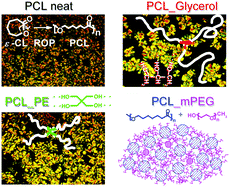Synthesis, crystallization, and molecular mobility in poly(ε-caprolactone) copolyesters of different architectures for biomedical applications studied by calorimetry and dielectric spectroscopy†
Abstract
In this work, we synthesized poly(ε-caprolactone) (PCL) and three copolyesters of different architectures based on three different alcohols, namely a three arm-copolymer based on 1% glycerol (PCL_Gly), a four arm-copolymer based on 1% pentaerythrytol (PCL_PE), and a linear block copolymer based on ∼50% methoxy-poly(ethylene glycol) (PCL_mPEG), all simultaneously with the ring opening polymerization (ROP) of PCL. Due to their biocompatibility and low toxicity, these systems are envisaged for use in drug delivery and tissue engineering applications. Due to the in situ ROP during the copolyesters synthesis, the molecular weight of PCL, Wm initially ∼62 kg mol−1, drops in the copolymers from ∼60k down to ∼5k. For the structure-properties investigation we employed differential scanning calorimetry (DSC and TMDSC), X-ray diffraction (XRD), nuclear magnetic resonance (NMR), Fourier transform infra red (FTIR) spectroscopy, polarized optical microscopy (POM), broadband dielectric spectroscopy (BDS) and isothermal water sorption. DSC revealed that the crystalline fraction of PCL increases whereas the crystallization rate drops in the copolymers in the order PCL ∼ PCL_Gly > PCL_PE ≫ PCL_mPEG, which coincides with that of decreasing Wm. In PCL_mPEG the major amount of PCL (87%) was found to crystallize while the majority of mPEG (92%) was found amorphous exhibiting constrained amorphous mobility and severely slower/weaker crystallization as compared to neat mPEG. Segmental dynamics in BDS, in agreement with DSC, is similar and in general slow for the samples of star-like structure for Wm ≥ 30k arising from PCL, whereas it is severely faster and enhanced in strength for the linear PCL_mPEG (lower Wm) copolymer arising from mPEG. For the latter system, the data provide indications for the formation of complex structures consisting of many small PCL crystallites surrounded by amorphous mPEG segments with constrained dynamics and severely suppressed hydrophilicity. These effects cannot be easily assessed by conventional XRD and POM, confirming the power of the dielectric technique. The overall recordings indicated that the different polymer architecture results in severe changes in the semicrystalline morphology, which demonstrates the potential for tuning the final product performance (permeability, mechanical).



 Please wait while we load your content...
Please wait while we load your content...